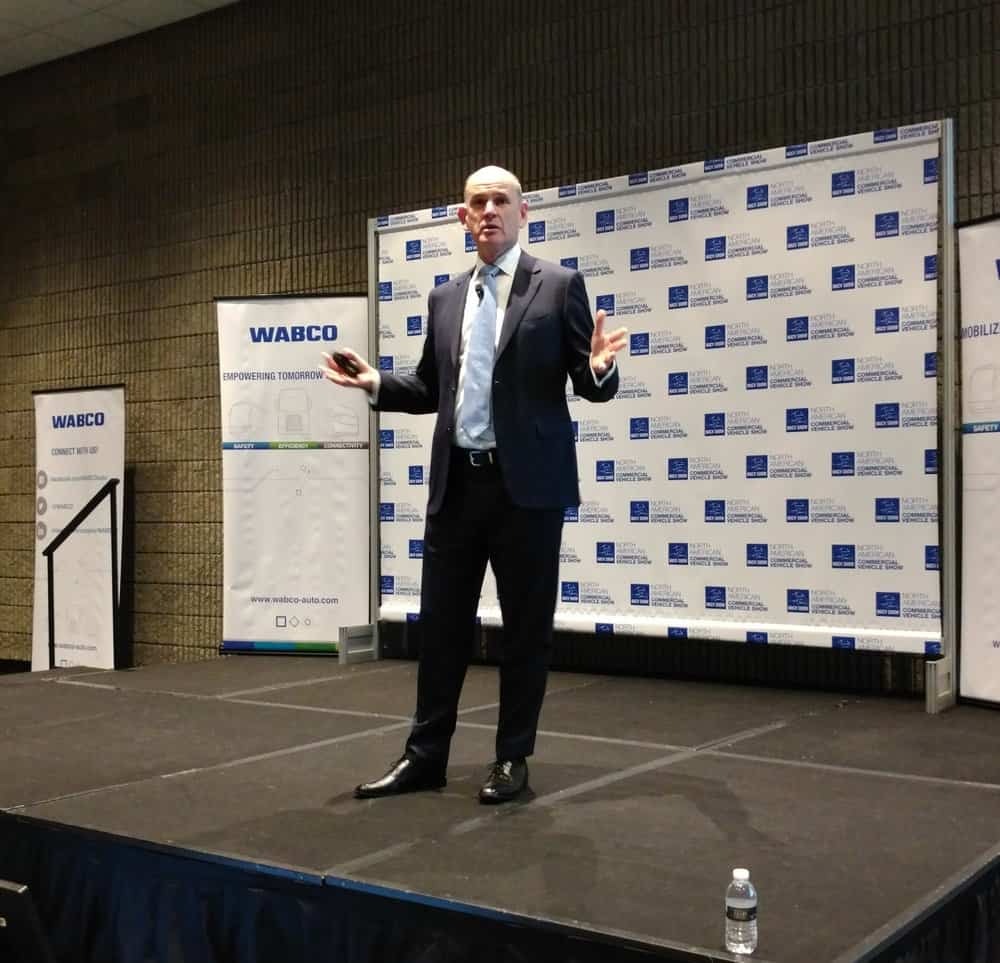
Wabco’s acquisition of the remaining 50% ownership stake Meritor held in the Meritor Wabco joint venture, which began 27 years ago, a few weeks ago is one of the steps Wabco is taking to ensure its continued growth and positioning for the future.
Jacques Esculier, Wabco chairman & CEO, explained how that strategic move and others are helping the company position itself for a connected future. He also highlighted some upcoming products from the company during a press briefing at the North American Commercial Vehicle show in Atlanta.
“The strategic purpose at that time (of starting the JV) was to have Wabco connect with the U.S. market,” he said. “Since then, the relationship has evolved as has the commercial vehicle business.”
Esculier said the time was right to acquire the entire JV to allow the Wabco team to sell the products globally. All current products produced under the joint venture can now be purchased through Wabco.
The JV acquisition, which is expected to close next week, along with the purchase of RH Sheppard will provide Wabco with about 25% of its global revenues next year.
RH Sheppard Co. supplies steering technologies for commercial vehicles. Based in Pennsylvania, Sheppard will play a key role going forward in Wabco’s growth, Esculier said.
Both acquisitions play into Wabco’s future plans around autonomous vehicles and safety systems. In the case of the Meritor Wabco buy, the products will form the basis for seamless integration of core technologies that will become the backbone of vehicle autonomy, Esculier said. Sheppard’s steering technologies will be overlayed with a magnetic torque overlay steering gear with Nexteer Automotive ECU to produce an active steering product.
That product, OnLane Assist, should be available in North America in 2019. It combines active steering with lane departure warning to actively redirect a vehicle back into its lane.
“I think that by combing lane departure with active steering, we will save a bunch of lives,” Esculier explained.
Another technology Wabco is developing and will be available by the end of the decade is OnGuard Max. This system takes its OnGuard Active product a step further, providing the ability to deploy full braking power in all weather conditions against stationary objects.
All of Wabco’s technologies will likely play key roles in developing autonomous vehicles. Esculier laid out Wabco’s path to autonomous vehicles. The first step is detection and includes the use of radars, sensors, Lidar and driver monitoring – all technologies that are in use and continually being advanced today. Second is to connect the vehicles, including platooning, followed by predictive and reactive control technologies. Esculier says this will likely be done through a partnership. Finally, is to activate all these systems – braking systems, active steering, stability control, sensors, AMT and more – into a single, cohesive system.
Esculier sees significant benefits from platooning, noting that fuel savings of 10% could be achieved, although there is a hurdle to that.
Currently, the OnGuard Active collision mitigation system allows a following vehicle to get as close as 2 seconds but current law requires 3.6 seconds between vehicles. But, by adding OnGuard Platoon technology in development, that gap could be closed even further, to 1.4 seconds. A further closing is possible if braking power of the lead vehicle is higher than trailing vehicles and each vehicle’s brakes are connected so that following vehicles start to brake the moment the lead vehicle does.
“Before you build a platoon, you have to reflect on what are the characteristics of the trucks to ensure the forward vehicle has more braking power than the following vehicle,” Esculier said.
Combined with a big data approach, Esculier says the distance between vehicles could go as low as 0.5 seconds.
Esculier also noted Wabco’s combination of trailer aerodynamic devices – OptiFlow trailer skirts, AutoTail and nose fairing – can provide up to 9% fuel efficiency improvement.
The AutoTail, he said, includes an industry-first auto deployment and retraction system that folds the device when the vehicle’s speed drops below 10 mph.










